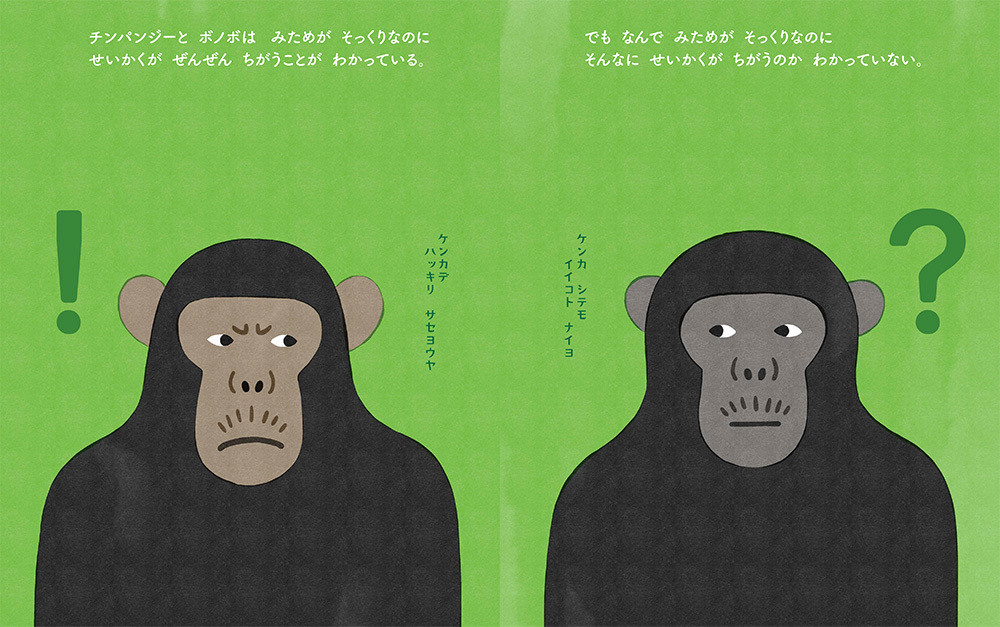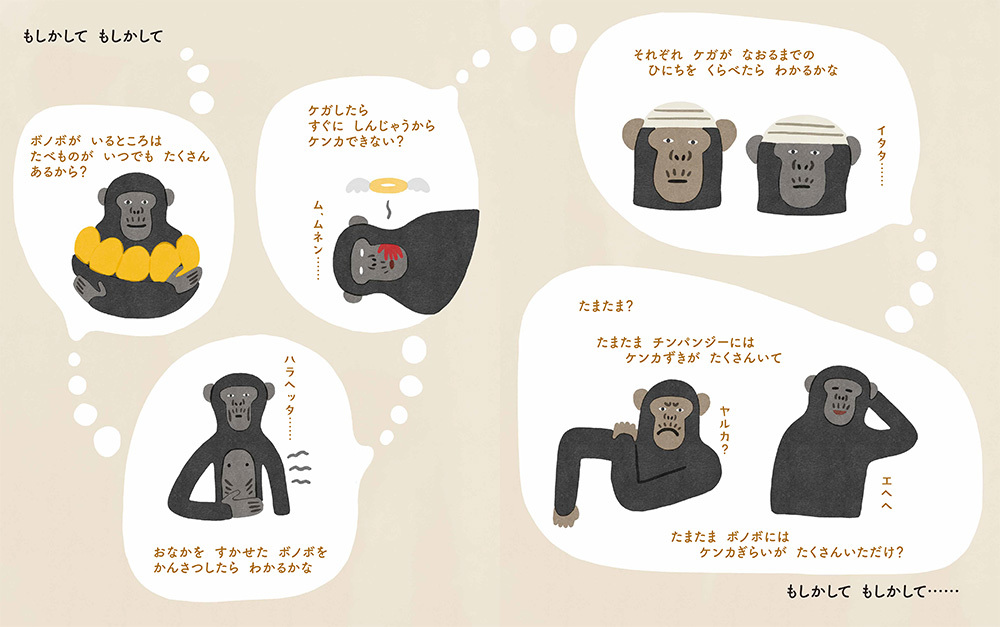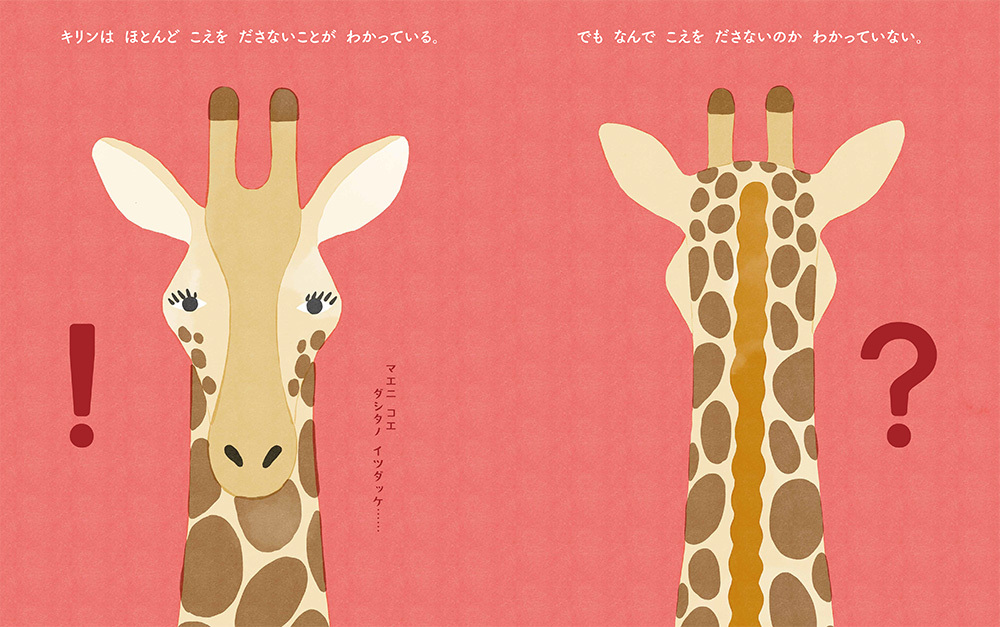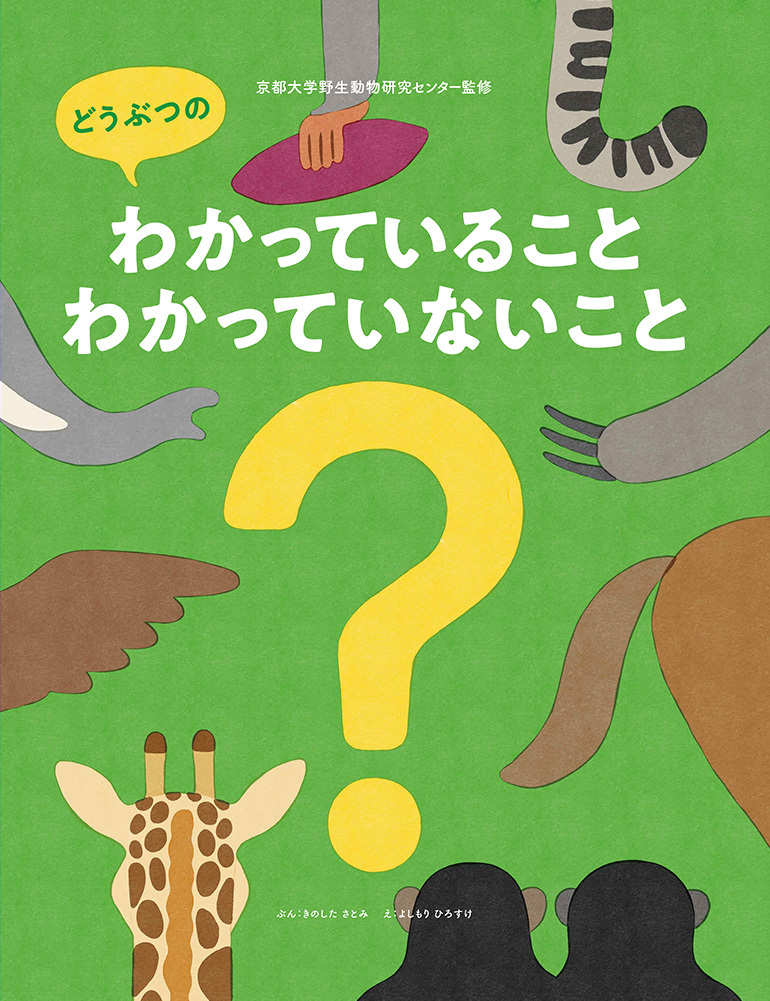DENTSU Ecosystem LAB confronts various challenges in ecosystem conservation and considers communication for solutions. In July 2022, the picture book " What Animals Know and Don't Know, " planned and written by LAB member Satomi Kinoshita, was published. It centers on the theme of "inquiry" practiced by wildlife researchers in their daily work.
This time, Kinoshita joins a roundtable discussion with Shinichiro Tsuzuki, President and CEO of Shogakukan Shueisha Productions (ShoPro), the publisher of the picture book; Assistant Professor Nahoko Tokuyama from Kyoto University's Wildlife Research Center, who served as supervisor; and Assistant Professor Kozue Kinoshita. They discuss the challenges in wildlife research that inspired the picture book's creation, the potential of inquiry-based learning (*) in education, and the importance of inquiry-based learning for companies considering ecosystem conservation.
※ = Inquiry-based learning
A learning method where students set their own challenges, gather and analyze information to solve them, and progress through discussions with others.
【DENTSU Ecosystem LAB】
A planning and creative unit that partners with researchers of wildlife, forests, rivers, and oceans, endangered species conservation groups, zoos, aquariums, and others to create communications centered on environmental issues, ecosystem conservation, and the SDGs.

From left: Satomi Kinoshita, President and CEO Shinichiro Tsuzuki, Assistant Professor Nahoko Tokuyama, Assistant Professor Kozue Kinoshita
A project born from exploring industry-academia collaboration between the Wildlife Research Center and companies, designed to communicate "research methods"
――First, could you tell us about the challenges in ecosystem conservation and wildlife research that led to creating the picture book?
Satomi Kinoshita (hereafter Kinoshita): When it comes to ecosystem conservation, the standard approach is to donate to wildlife conservation organizations like WWF or collaborate with them on local projects. On the other hand, understanding the subjects (animal ecology and habitats) and supporting such research is also crucial for conservation. Discussing with my twin sister, Dr. Kinoshita, who co-planned this project, we recognized that large animals have long lifespans, making research time-consuming and costly. We felt there were challenges in securing research funding and in educating the next generation.
Kozue Kinoshita (hereafter Kinoshita K): Kyoto University has been promoting industry-government-academia collaboration for several years now, aiming to invigorate joint research with companies and government agencies and apply research outcomes to industry. While industry-government-academia collaboration demands research addressing societal needs, wildlife research is less directly relevant to everyday life compared to medicine or engineering. Therefore, when we held brainstorming sessions with DENTSU Ecosystem LAB and other companies to explore how the Wildlife Research Center could collaborate with businesses, the idea emerged that leveraging the universally familiar theme of "animals" as a strength could be an effective approach.
Kinoshita: We first produced a PR video to communicate the research conducted at the Wildlife Research Center. After sharing it internally and discussing it with Ecosystem LAB members, someone remarked, "The way you approach research into animal mysteries is really fascinating." We wondered if there might be topics within your research methods that could be shared with the world. That's how the idea for a book exploring both "what we know" and "what we don't know" was born. We later learned this approach is called "inquiry-based learning." We decided to draft a proposal and present it to ShoPro.

――I understand ShoPro has been advancing initiatives related to inquiry-based learning for some time. What led you to participate in this project?
Tsuzuki: While our company handles early childhood education, it's not focused on textbook-based exam preparation. In current education, for example, some teachers might say that "4.0" is correct for "1.2 + 2.8" but "4" is wrong. I've always felt uneasy about this aspect of Japanese education, where there's a predetermined correct answer and anything else is considered wrong. Discussing the education needed for the future, we recognized challenges in implementing inquiry-based learning—where students proactively engage with "not knowing"—and in developing non-cognitive skills. Especially in early childhood education, we wanted to value fostering curiosity, imagination, and the ability to question things. When I saw Satomi Kinoshita's project in the publishing division, I found it aligned perfectly with these themes and thought it was fascinating.
Tokuyama: I joined partway through, but when I heard about the inquiry-based learning theme, I felt it was a project that could effectively convey the fascinating aspects of research. We only write about what we "discovered" in papers, but before finding that fact, we repeatedly try things like "We tested this, but it was wrong." And that part, which doesn't appear on the surface, is actually the most interesting part of research.
The seed for the picture book emerged from implementing a children's event
――I heard you also held events with the zoo while creating the book. What was the purpose and content of these events?
Kinoshita: ShoPro proposed the event concept. Amidst the recent flood of books focusing on animal trivia (the "known facts"), we weren't entirely sure what a picture book highlighting the "unknown" could offer readers. So, we thought that by holding an event aligned with the book's theme at a zoo where children could observe live animals and gauge their reactions, we might find a way forward.
The event involved children participants proposing hypotheses like "Maybe it's because of XX?" regarding animal mysteries still unsolved worldwide. They then collaborated with teachers and zoo staff to devise ways to test these hypotheses. With the cooperation of Kyoto City Zoo, we formed four teams: each team included a researcher, a keeper, and a facilitator from ShoPro, with Dentsu Inc. handling overall assistance.
Kinoshita Ko: We approached the children as professionals with "research knowledge," while the zoo staff were professionals with "animal knowledge." The children's ideas were things that wouldn't occur to adults with fixed mindsets, and it made us realize how flexible their perspective on animals is.
Tokuyama: Everyone was genuinely moved reading the submitted hypotheses. While some were wildly outlandish ideas typical of children, it was incredibly fun for us researchers to figure out how to test them. That kind of thinking would never have emerged from an adult-only planning session.
Tsuzuki: My favorite was the hypothesis proposed for the question: "Chimpanzees and bonobos look the same but are different. Chimpanzees fight among themselves, but bonobos don't. Why?" It was: "Maybe chimpanzees get good things when they become important, but bonobos don't." Even if it wasn't the correct answer, the act of thinking like this is incredibly important, for example, when creating stories. I think it was a learning method that didn't stifle the buds of flexible thinking.
Tokuyama: This hypothesis actually hits the essence. The words are simple, but it's close to what we're trying to understand. Another interesting one was "Chimpanzees fell into darkness." I never would have come up with that myself (laughs).


Top: Page showing "known facts" and "unknown facts" about chimpanzees and bonobos / Bottom: Hypotheses about "unknown facts," including ideas children came up with at the event
Tsuzuki: Our educational philosophy includes the term "edutainment," a portmanteau of entertainment and education. We always strive to practice learning methods that are enjoyable and fun, and I believe this event was truly edutainment.
We want them to understand the importance of continuing to think about "what we don't know."
――Considering the children's opinions and the event, what points did you particularly prioritize when developing the book?
Kishita: Our primary focus was on how to convey the joy of having questions and curiosity, and the pleasure of thinking for oneself. The book features four main animal mysteries. We deliberated repeatedly with the ShoPro Publishing Department staff on how to connect these four mysteries and, by not presenting conclusions, how to encourage readers to keep thinking about the "unknown."
Tokuyama: From the supervising editor's perspective, balancing accuracy about the animals with clarity for children was both challenging and enjoyable. For example, most animals don't normally have "white eyes." Humans have them because eye contact is important for communication, but for many animals, it's better for catching prey or escaping predators if their gaze isn't easily discernible. The animals in the book didn't have white eyes when we created the event materials, but after many discussions, we decided adding them would make the picture book more approachable and friendly.

A page from the picture book where "white of the eye" was added
Kinoshita Ko: To spark deep interest in animals, I aimed to present content that shows they're creatures full of wonders, just like humans, rather than just delivering one-sided trivia. Publishing books that are enjoyable to read without being overly educational is important. With many animals facing extinction and wildlife researchers themselves becoming fewer, I hope this also contributes to nurturing the next generation of researchers.
Tsuzuki: Our flagship work, Detective Conan, has the signature line "There is always only one truth!" But I want children to understand that answers to such questions aren't always singular. When I was a child, the theory that dinosaurs evolved from lizards was considered correct, but now the theory that they evolved from birds is more widely accepted. In that way, there are still many things in the world we don't understand, and I'd be happy if we could convey that it's important to think about the things we don't know.
The mindset needed to tackle things without clear answers is also valuable for business and companies.
――Could you share your discoveries and perceived benefits from this industry-academia collaboration?
Tsuzuki: Companies inevitably tend to attract similar types of people. Working with individuals from different backgrounds and perspectives is truly creative. I spent a long time in magazine editorial departments, and within one department, everyone's thinking inevitably becomes similar over time. Introducing an outsider sparks new ideas and creates a chemical reaction. I hope to continue these kinds of initiatives going forward.
Kishita: This project started when we revisited research methods that the Wildlife Research Center professors considered "standard practice," only to realize those methods weren't "standard" for people with different backgrounds and work experiences. This discovery emerged precisely because we had completely different perspectives and ways of thinking. While there are advantages to creating this book solely with the professors or solely with our team, collaborating with people from different fields undoubtedly led to more discoveries.
Tokuyama: Absolutely. We ourselves had become so accustomed to our methods that we were oblivious, but we learned that within the routines of researchers lie points that others find fascinating or useful. Since researchers are now also expected to "communicate," we learned a great deal about expression methods and more.
――The picture book focuses on "inquiry-based learning" for children. Could you share any insights on the usefulness of inquiry-based learning for business professionals and companies?
Kinoshita: While developing events and the picture book around the "inquiry-based learning" theme, the members themselves learned a lot from exploring without knowing the right answers. Companies are now also being asked to pursue "Sustainable Transformation (SX)." In the sense that there are no clear answers, I feel it's important to learn methods for sustained long-term thinking, much like the professors' research.
Tsuzuki: When interviewing new graduates, I find no interest whatsoever in answers that seem like memorized job-hunting scripts. I genuinely want to know the answers they've arrived at through their own thinking, and I want to work with people who can think that way. Also, I feel many of the currently thriving companies in Japan are owner-managed businesses. It's difficult to foster innovation in corporations where meeting numerical quotas becomes the sole focus of work. Owner-managed companies, however, can pursue initiatives that don't directly translate to sales if the owner says, "Let's do it." Companies that can adopt perspectives beyond mere numbers and aim for things without an absolute "right answer" are strong.
Preserving biodiversity requires "inquiry skills." Companies must also adopt long-term thinking.
――Could you share any thoughts on future initiatives?
Kinoshita: This was our first industry-academia collaboration. Moving forward, while pursuing research as our primary duty as researchers, we'd be delighted to collaborate with an even broader range of companies and businesses. We also hope to cultivate more of those seemingly peripheral elements gained during research, which might prove useful somewhere down the line.
Tsuzuki: Alongside developing this picture book series, we want to explore how to integrate these concepts into our educational initiatives. Rather than seeking a single "correct answer," we aim to practice education rooted in fostering innovative thinking that embraces diverse possibilities without dismissal.
Kishita: I also want to turn this book into a series.
Furthermore, as Ecosystem LAB, we aim for long-term activities as corporate initiatives toward SDGs and biodiversity become more active.
We're now frequently hearing statements like "2022 marks the start of the Year of Biodiversity" at corporate seminars. That said, biodiversity conservation is a complex issue where both solutions and quantification are difficult, making the "right answer" hard to pin down. Even if just one endangered species increases, or if only the number of species grows due to invasive species, the ecosystem loses its balance. To move forward while maintaining that balance, a truly long-term perspective is essential. The concept of inquiry-based learning is crucial for companies and researchers tackling these "problems without clear answers." We intend to continue supporting the parallel efforts of wildlife researchers and businesses moving forward.






















